Neil Peart's Time Machine drum setup in pictures
A look at the Rush drummer's elaborate tour setup
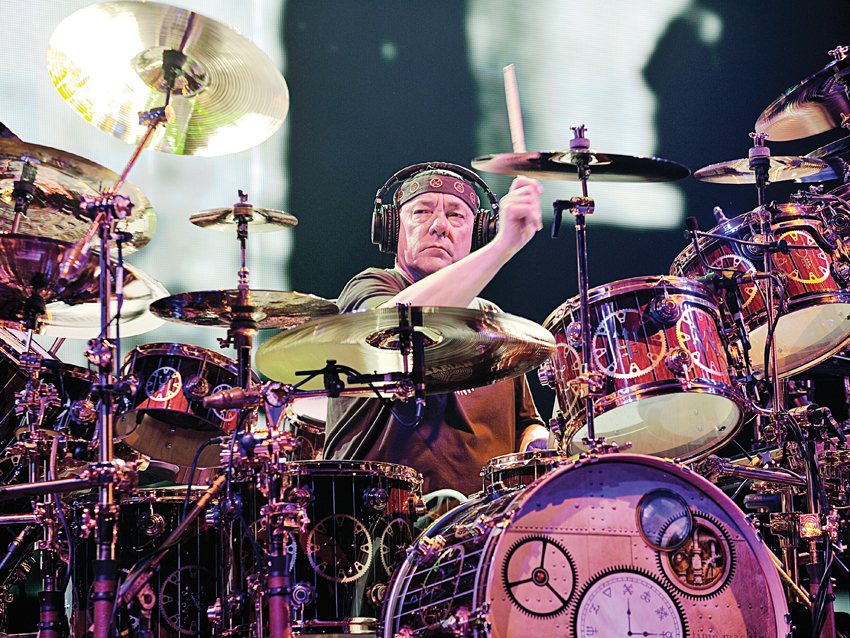
Neil Peart's Time Machine drum setup in pictures
“It’s been my life’s tangent,” says Neil Peart on the subject of the pursuit of excellence. Since he joined Rush back in 1975, Neil has been the poster boy for prog - disciplined, metronomic and powerful.
When you meet him in person it is easy to see where the power comes from - he’s an imposing guy, a fact often obscured by the gargantuan drum kit that usually surrounds him.
Watching Rush onstage during their current Time Machine tour, it is clear that something fundamental has changed. The band known for meticulously recreating their studio recordings live on stage are jamming. More than 35 years since Neil joined the world’s foremost power trio, Rush are still pushing themselves and breaking new ground.
Rhythm Magazine met up with Neil and his drum tech Lorne Wheaton backstage at London’s O2 Arena to talk about his kit, technique, influences and constantly developing as a drummer.
Here we bring you shots of Neil’s Time Machine tour kit, along with snippets from that interview, which you can read in full in Rhythm 192. Or you can subscribe to Rhythm Magazine to read interviews with the world’s top drummers each month.
- Find your next setup with our guide to the best drum kits
Next: The kit
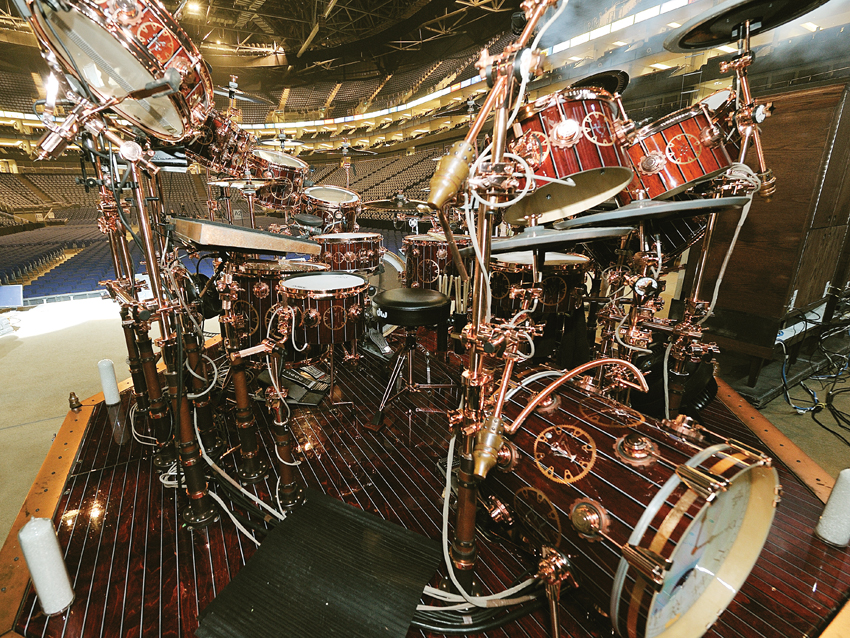
The kit
Drum Workshop Collectors Series in Steampunk finish: 23-inch bass drum (VLX shell series); 8-inch, 10-inch, 12-inch and 13-inch rack toms (X-shell series); 15-inch (x2), 16 and 18-inch floor toms (VLT shell series); 14x6½-inch VLT series snare; 13-inch X-shell series piccolo snare.
Neil’s long-time drum tech Lorne Wheaton gives us the lowdown:
“Neil’s been playing Drum Workshop since 1995. The first tour he did with DW was the Red Sparkle kit on the Test For Echo tour and we used that for Vapor Trails too.
"Then we went into R30 (the Rush 30th anniversary world tour) with the custom-built kit with the Rush logos, then the Snakes And Arrows tour, and this is where we’ve ended up, with the new Time Machine kit. Louie [Garcia, DW master craftsman and artist] spent so much time building and finishing it.
“The shells are one-ply of walnut on the outside which we match with the deck on the riser. They’re all maple shells and a mixture of VLT, VLX and X-shells.”
Next: Cymbals
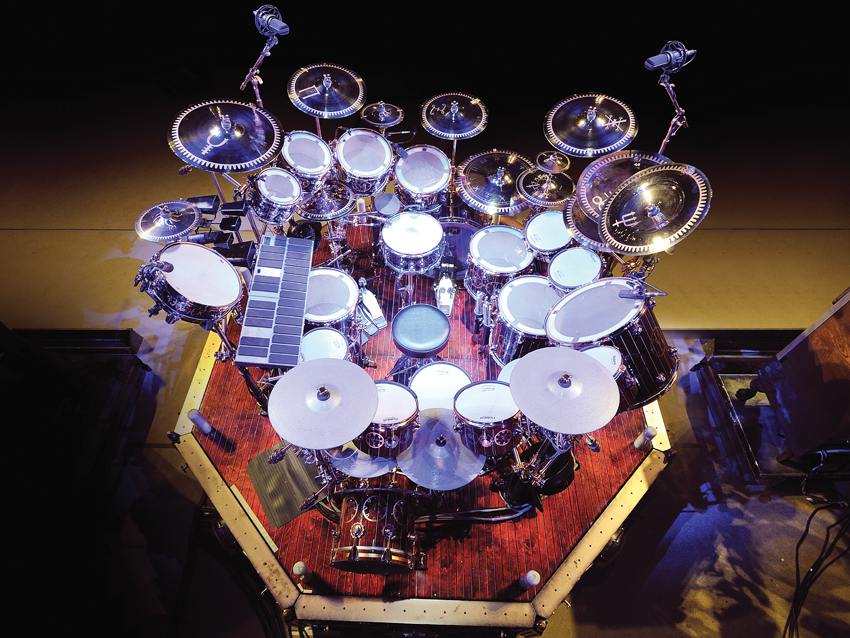
Cymbals
Sabian Paragon Brilliant finish cymbals with a custom Steampunk design applied by the factory: 10-inch splash (x2); 16-inch (x2), 18 & 20-inch crashes; 14-inch hi-hats; 22-inch ride; 14-inch Artisan Brilliant X-hats; 8-inch splash (mounted above the hats); 20-inch china beneath a 20-inch Diamondback china (cymbal with the jingles and rivets); 19-inch china.
Lorne explains:
“We have Sabian brilliant Paragons. I clean Neil’s cymbals every day. With the old natural finish Paragons, after about six or seven shows I’d pretty much have them down to a brilliant finish anyway from buffing all the metal out of them.
“The only drawback of that is they’d break because you’re drawing metal out every time you’re cleaning them. With the brilliant finish they buff them at the factory and make them so durable. I’ve had this set of cymbals since the start of this leg of the tour and we haven’t broken one. And he hits very hard.
“We’ve got the gears on top of the cymbals because we have an overhead camera and it plays to the steampunk theme. We use all the same type of graphics on the shells, copper and chrome leaf inlays.”
Next: Heads and hardware
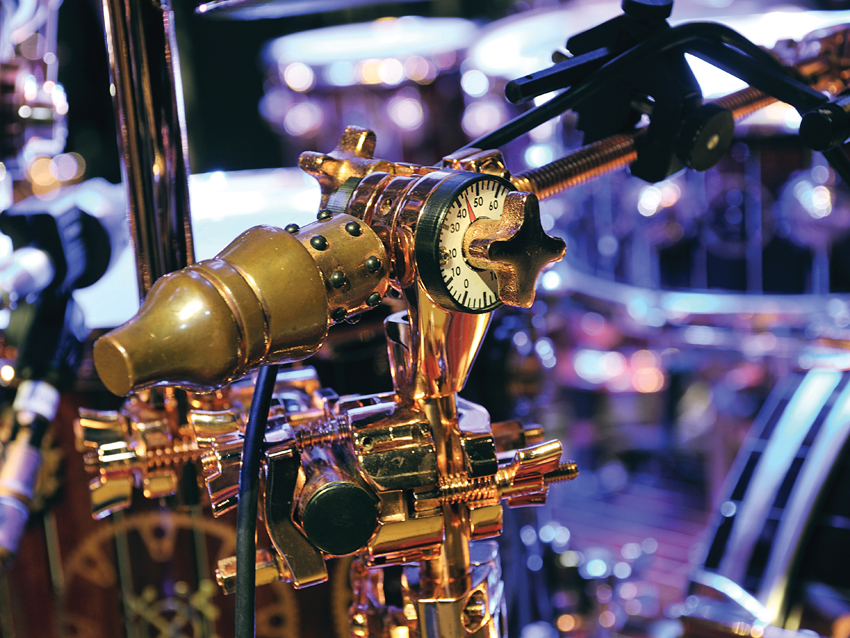
Heads and hardware
Heads: Remo Clear batter heads on toms, Remo Ambassador X snare batter heads, Powerstroke 3 on bass drum.
Hardware: Copper-plated DW 9300 series hardware, 5000 series DW hi-hat pedal, 9000 series DW double bass drum pedal; Pro-Mark Neil Peart Signature 747 drumsticks; 9ft x 9ft Octagonal rotating drum riser in Steampunk finish; Squirrel cage fans (x2, to cool his hands); Kelly SHU internal kick drum microphone mount.
Lorne says:
“We’re using Remo clear heads on toms and an Ambassador X coated on the snare now. They’re a lot more durable. It’s all DW hardware, copperplated.
“The gauges and dials were all Neil’s idea. DW were kind enough to run out to the closest hardware store to try and get some of this stuff and send it off to the platers.
“All the video panels on the riser are from a guy called Greg Russell and a prop company in Hollywood.”
Next: Electronics
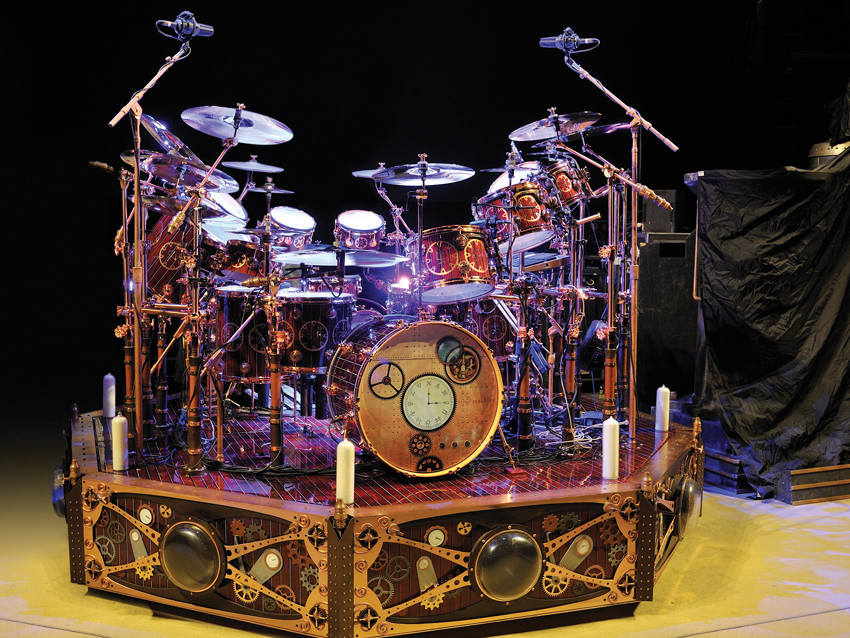
Electronics
Roland TD-20X V-drum triggers (mounted in DW Collector series shells), Roland V cymbals and hi-hats, Dauz trigger pad, Fat Kat trigger pedals, Mallet Kat Express (Midi Marimba), Roland V-drum TD-20KX percussion modules (x2), Roland XV 5080 samplers (x2), Glyph hard drives, Roland Midi Displays, Behringer line mixer, Monster power conditioner.
Lorne says:
“Round the back it’s all V-drums, the TD-20KX. We use the stock pads, the same that we’ve been using since the Vapor Trails kit, but I take the triggers out and have DW build shells that we mount them into.
“The rack is pretty antique. We’re not using laptops; it’s all hard drives and actual samples. I also use Roland Midi Displays. I can actually see Neil play the midi note on the V-drum stuff while he’s doing his solo. You can’t find them anywhere. Not even on eBay!”
Next: The pursuit of sound
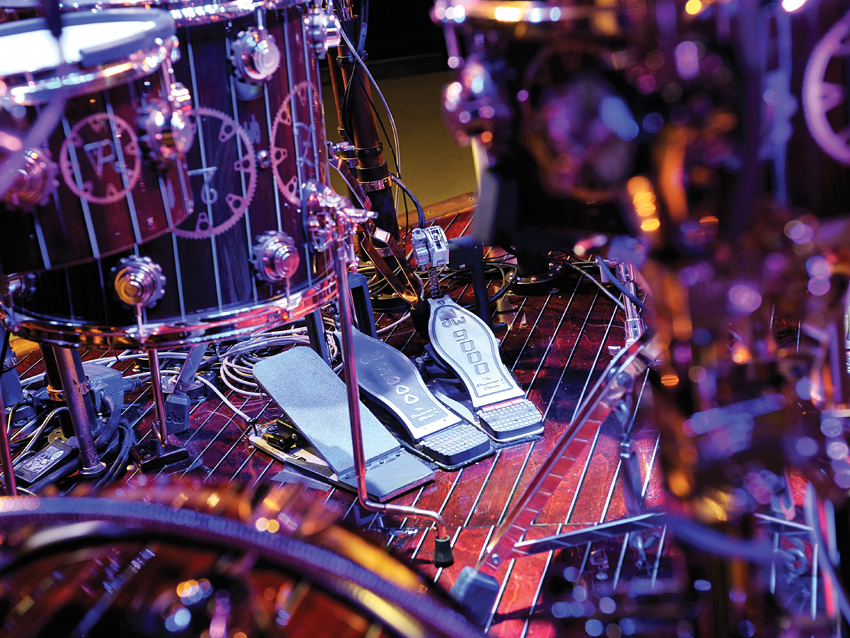
The pursuit of sound
For Neil the process of working with drum and cymbal makers to find perfect sounds is one of collaboration and inspiration:
“With Sabian it was the development of the whole line of cymbals that started from a piece of metal on a stand,” Peart tells us. “Mark Love and I tried everything possible to find out what I liked the best and what worked the best for me so that was how in-depth that process was of metallurgy and music.
“I was having a discussion with John Good at DW one day and I was saying that when we used to open shows in those days a lot of drummers were using 24-inch bass drums. I used to love the way they sounded out-front through the PA but I never liked the way they played so I always went with a 22-inch.
“John said, ‘What about a 23-inch?’ I said, ‘There’s no such thing.’ And he had to make the shell, get the Remo drum head company to make 23-inch heads and all of that came out of that discussion.
“That’s how eager he was to try it and of course the 23-inch bass drum not only works so great for me but a lot of other drummers are finding that too. I love the collaborative aspect of that.”
Next: Keeping time
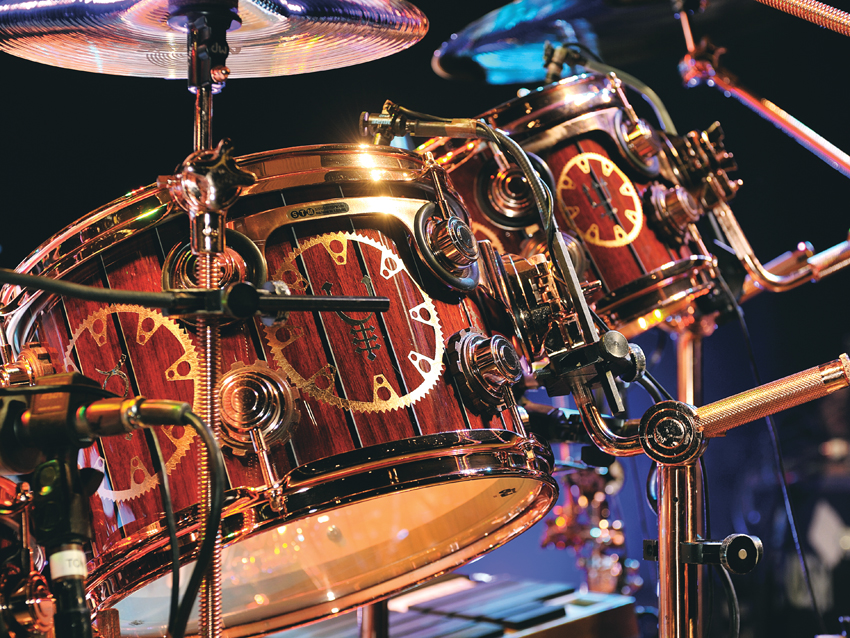
Keeping time
So what drives your timekeeping?
“It’s from my bass drum. That is the fundamental that Geddy hangs his bass parts off of, and thus the band hangs from in a very real sense, or is built from.
“The bass drum is the heart of it and I know that I feel and play and position those bass drum notes a little differently now. It’s so subtle it couldn’t be measured, using anticipation, using tension, pushing a little bit on purpose.
“One of the older songs that we’re playing, ‘Presto’, is from ’79 and I don’t know if we’ve played it ever, or we haven’t played it for 30 years. It’s one of those that we play so much better than the record in a feel sense, a rhythmic sense.
“I was saying to my bandmates how much better that song is now than it was on the record and Geddy said, ‘Yeah, we have a so-much-better rhythmic pulse now than we did back then.’"
Next: Learning to improvise
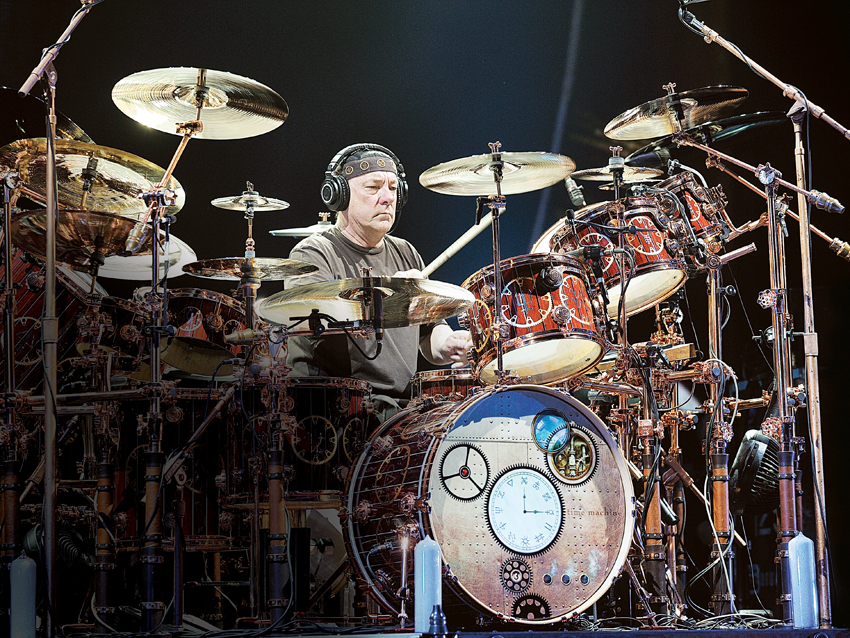
Learning to improvise
Your live solos continue to evolve. How do you avoid getting stuck in a rut?
“I deliberately set out to learn [to improvise], within the context of my solo, making the first half of it improvisational over three different ostinatos, and then the second half was composed, so I know it is always going to resolve into something from the audience’s point of view.
“Pure improvisation, everybody knows, is inherently risky. I remember seeing the Grateful Dead years ago and Mickey Hart met me before the show. He said, ‘We had a really good show last night so we probably won’t have another one for the next three or four days.’
“That’s just the cycle that is necessary if you devote yourself to improvisation. I improvise within a framework but I’ve been able to take myself so far out of my former comfort zone with that kind of nurturing over time from teachers like that and inspirations.”
Next: The benefits of touring
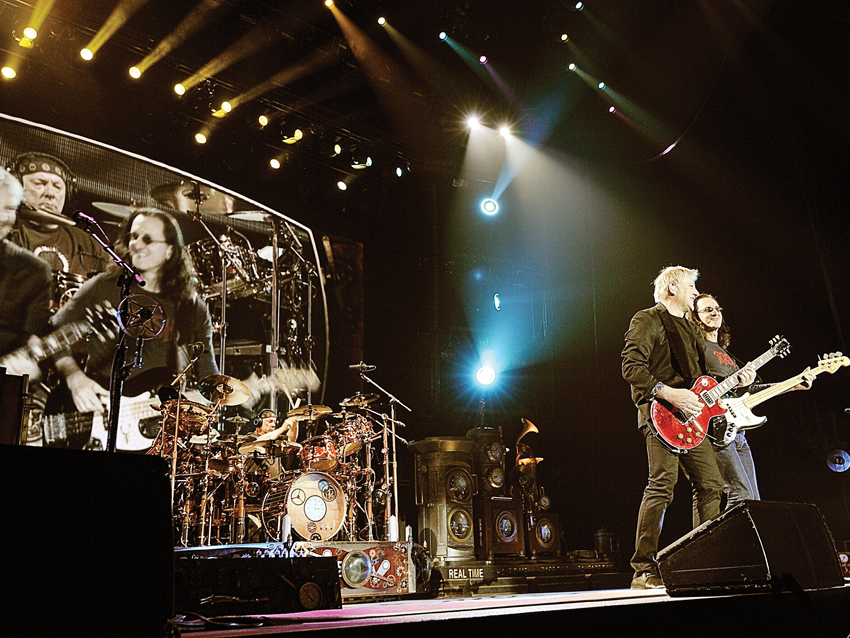
The benefits of touring
What keeps you on the road after so long?
“The real test of a musician is live performance. It’s one thing to spend a long time learning how to play well in the studio but to do it in front of people is what keeps me coming back to touring, because I really don’t like it but it’s necessary.
“For me to call myself a musician it’s necessary to play live and it rewards so much, not just in the pay cheque sense but what it does for my playing. I feel it through a tour, I feel it at the end of a tour, all that I’ve gathered and especially now that I am improvising so much, all that I am exploring, all the new ideas I have.”
Check out Neil's Time Machine kit on video over at the Rhythm Magazine site.
Now check out Rhythm’s current issue 193 featuring an exclusive interview with Queens Of The Stone Age drummer Joey Castillo. Or subscribe to Rhythm here for a monthly dose of new gear reviews, kit buying guides, pro drum lessons and all-star interviews.
Liked this? Now read: Access All Areas: On the road with Rush
Connect with MusicRadar: via Twitter, Facebook and YouTube
Get MusicRadar straight to your inbox: Sign up for the free weekly newsletter









